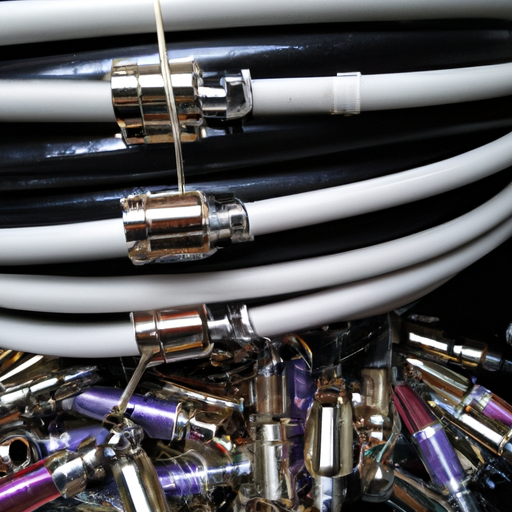Multi-resonant antennas have become increasingly popular in recent years due to their ability to operate at multiple frequencies simultaneously. These antennas are capable of resonating at multiple frequencies, allowing for increased bandwidth and improved performance in a variety of applications. In this article, we will discuss the latest specifications and advancements in multi-resonant antennas.

The latest multi-resonant antennas are designed to cover a wide range of frequencies, from a few megahertz to several gigahertz. This makes them suitable for a wide range of applications, including wireless communication, radar systems, and satellite communication. In addition, these antennas are often compact in size, making them ideal for use in portable devices and small form factor applications.
One of the key challenges in designing multi-resonant antennas is achieving good isolation between the different resonant modes. Cross-coupling between the resonant elements can lead to interference and reduced performance. To address this issue, designers use techniques such as electromagnetic bandgap structures, decoupling networks, and isolation elements to minimize cross-coupling and improve the overall performance of the antenna.
Another important consideration in multi-resonant antenna design is the impedance matching. The antenna must be matched to the impedance of the transmission line or the RF circuit to ensure maximum power transfer and efficiency. This is typically achieved through the use of matching networks, such as baluns, transformers, and matching capacitors, which are carefully designed to match the impedance of the antenna to the impedance of the circuit.
In terms of materials, the latest multi-resonant antennas are often made from high-performance dielectric materials, such as ceramics, polymers, and composites. These materials offer high dielectric constants, low loss tangents, and excellent mechanical properties, making them ideal for use in high-frequency applications. In addition, these materials are often lightweight and durable, making them suitable for use in portable and outdoor applications.
One of the key advantages of multi-resonant antennas is their ability to provide increased bandwidth compared to traditional single-resonant antennas. By operating at multiple frequencies simultaneously, these antennas can cover a wider range of frequencies and support multiple communication standards. This makes them ideal for use in multi-band communication systems, where a single antenna can support multiple frequency bands.
In conclusion, multi-resonant antennas offer a number of advantages over traditional single-resonant antennas, including increased bandwidth, improved performance, and compact size. The latest multi-resonant antennas are designed to cover a wide range of frequencies, with high efficiency and low cross-coupling between the resonant modes. By carefully designing the antenna structure, tuning the resonant elements, and using high-performance materials, designers can create antennas that meet the demanding requirements of modern communication systems.
Multi-resonant antennas have become increasingly popular in recent years due to their ability to operate at multiple frequencies simultaneously. These antennas are capable of resonating at multiple frequencies, allowing for increased bandwidth and improved performance in a variety of applications. In this article, we will discuss the latest specifications and advancements in multi-resonant antennas.

The latest multi-resonant antennas are designed to cover a wide range of frequencies, from a few megahertz to several gigahertz. This makes them suitable for a wide range of applications, including wireless communication, radar systems, and satellite communication. In addition, these antennas are often compact in size, making them ideal for use in portable devices and small form factor applications.
One of the key challenges in designing multi-resonant antennas is achieving good isolation between the different resonant modes. Cross-coupling between the resonant elements can lead to interference and reduced performance. To address this issue, designers use techniques such as electromagnetic bandgap structures, decoupling networks, and isolation elements to minimize cross-coupling and improve the overall performance of the antenna.
Another important consideration in multi-resonant antenna design is the impedance matching. The antenna must be matched to the impedance of the transmission line or the RF circuit to ensure maximum power transfer and efficiency. This is typically achieved through the use of matching networks, such as baluns, transformers, and matching capacitors, which are carefully designed to match the impedance of the antenna to the impedance of the circuit.
In terms of materials, the latest multi-resonant antennas are often made from high-performance dielectric materials, such as ceramics, polymers, and composites. These materials offer high dielectric constants, low loss tangents, and excellent mechanical properties, making them ideal for use in high-frequency applications. In addition, these materials are often lightweight and durable, making them suitable for use in portable and outdoor applications.
One of the key advantages of multi-resonant antennas is their ability to provide increased bandwidth compared to traditional single-resonant antennas. By operating at multiple frequencies simultaneously, these antennas can cover a wider range of frequencies and support multiple communication standards. This makes them ideal for use in multi-band communication systems, where a single antenna can support multiple frequency bands.
In conclusion, multi-resonant antennas offer a number of advantages over traditional single-resonant antennas, including increased bandwidth, improved performance, and compact size. The latest multi-resonant antennas are designed to cover a wide range of frequencies, with high efficiency and low cross-coupling between the resonant modes. By carefully designing the antenna structure, tuning the resonant elements, and using high-performance materials, designers can create antennas that meet the demanding requirements of modern communication systems.